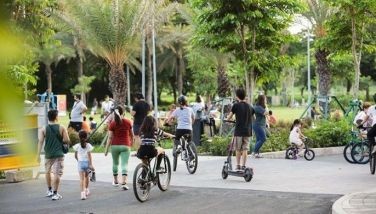SPECIAL REPORT: #YolandaPH: A story of tragic loss
CEBU, Philippines - Losing people we consider important in our lives, whether family members or friends, is one of the most painful human experiences.
And this is exactly what super typhoon Yolanda brought to the lives of many of those who survived its wrath – pain and longing for those they have lost. Add to this the fact that most of those who survived saw, with their very own eyes, how their loved ones fought for their lives but failed.
THE WATERS THAT WASHED LIVES AWAY
Tacloban
Lorna Mabag, 40, lost five children at the height of super typhoon Yolanda last November 8, 2013.
She, however, only found out about her tragic loss after she was informed by her neighbors that the bodies of her children were buried in a mass grave, after she woke up from days of being unconscious. She was not given a chance to even see her children’s remains because she was recovering at the hospital after she was injured when the storm surge washed their coastal community away.
Mabag, almost a year after Yolanda unleashed its wrath, still finds it hard to talk about what happened to her family. In fact, she had to walk away sobbing in the middle of the interview with The Freeman.
She resides, up to this day, in a tent home in Mahusay Beach, San Jose District, Tacloban along with 76 other families who were each given tents by the United Nations.
Her neighbor, Precela Mia, who survived the storm surge along with two of her children, lost three family members (daughter, son-in-law, grandchild).
“We were all supposed to be staying at the evacuation center. I was at the astrodome, they were at the barangay hall. But on the day of the typhoon, they went back to their house. I looked for them after the storm but found out that they died. My grandchild, who died with her parents, was six months pregnant. Her husband was checking on his parents when the storm surge hit. He tried to save his wife but to no avail,” Mia shared.
Like Mabag, she returned to Mahusay Beach, the exact place where she lost her family. Authorities have been planning to clear Mahusay Beach, located a few meters from the Tacloban airport, from homes like that of Mabag, Mia and others but the residents remain defiant.
“Unless the government gives us a decent permanent relocation, we will never leave this place. This is the place where we all grew up, created our own family and also lost them. This place is very important to us. We can’t stay at the bunkhouse because there are no utilities. It is also very hot there. Our children are getting sick,” Mabag said.
Meanwhile, Samuel Cinco, 46, was fighting to survive the storm surge when he saw his 72-year-old father, Gaudencio, also trying to stay afloat despite strong waves.
Cinco, worried about his father who had been suffering from asthma then, remembers telling him to fight and try to survive. His father, already weak and pale at that time, did not respond to him. Cinco did not expect that was his last conversation with his father. Both of them were washed away by the huge waves and debris at the height of the super typhoon.
Being the eldest among four siblings, Cinco was close to his father. Both of them did not evacuate their houses in Barangay 88 San Jose, Tacloban City hours before the storm surge because they had to guard their houses and their animals.
“Nung tumaas na ang tubig, hindi ko na alam ang nangyari. Naanod na kaming lahat. Sa tubig na kami nagkita ni papa. Buhay pa siya pero hindi na niya kayang sumagot,” he said.
He managed to grab the arm of his father but when two huge waves came in succession, they got separated. Debris from destroyed houses made it hard for them to fight for their lives.
Cinco got hold of a rope and was washed ashore one kilometer from where his house stood. “Ginawa ko lahat para mailigtas kami pero hindi ko nakaya. Akala ko nga hindi rin ako makakaligtas,” he said.
Though he, his mother and siblings, who were in an evacuation center when the storm hit, survived, Cinco said they never found his father’s body.
He blames the government for the lives that were lost and the properties that were damaged, saying that they were not properly informed about the danger of storm surges.
“Kung pinaintindi nang maayos, nakaalis kaming lahat pero walang sinabing ganun ang mangyayari,” he said.
Palo, Leyte
A week before November 8, 2013, Leo Quijada Jr. of Barangay Salvacion, Palo, Leyte dreamed that his 63-year-old mother, Segundina, would die.
He never told his mother since he did not believe in dreams. His tragic dream, however, came true when Segundina and Leo’s sister, Irene, died at the height of the super typhoon Yolanda.
Leo is the third among the 10 children of Segundina and Leo Quijada Sr., who have been married for 40 years and even celebrated their wedding anniversary a month before the storm.
When super typhoon Yolanda struck, Leo heard a loud explosion. Minutes after, a mixture of sea and flood waters came rushing into their house.
Leo and seven other family members were trapped inside their house, which was located a kilometer away from the sea. When the storm surge rushed in, they all got separated.
While the storm surge continued its path of destruction, Leo, who does not know how to swim, had to decide who to save – his sister Irene who had a weak spirit and did not know how to swim, or another sister, Carmela, who was eight months pregnant. He eventually decided to save Carmela because of her condition.
Leo, however, was washed away by the storm surge, bumped into debris and injured his head. He was under water for an hour, during which he thought it was the end for him.
Prayer gave him strength and he was able to swim upwards, finding a coconut tree to hang on to. He managed to climb a little higher and found a sea full of debris. He could only see the roof of the two-storey houses in their area.
Leo found his brothers, Simon and Elmer, at noon that day and found their pregnant sister Carmela in the afternoon. They found the body of their mother after 21 days but never found his sister Irene.
“At least may pamilya pa rin kami. Hindi namin kayang magalit sa Panginoon,” he said.
Thirteen-year-old Raymark Avila lost his 7-year-old sister Myra when super typhoon Yolanda struck their area in Palo, Leyte.
Raymark was in the barangay hall with his mother and sister, along with their neighbors who evacuated in the area, hours before Yolanda battered the region.
He recalled that he got separated from his mother and sister when the first huge wave splashed into the barangay hall. Raymark was able to hold on to a steel bar and from where he was, he saw his mother and Myra at the middle of what looked like a “black sea.” When another huge wave came, Raymark saw how Myra got separated from their mother and was washed away by the huge waves.
“Nakita ko pa kamay niya. Lampas na sa kanya ang tubig. Tapos nawala na siya,” he said.
Hours after the typhoon, Raymark looked for his sister and later found her body covered with mud and garbage just a few meters from the barangay hall.
Raymark said that until now, every time there is heavy rain, the children in their barangay would cry, fearing it would bring another destructive typhoon like Yolanda.
The victim and the comforter
Ormoc City, located some 50 kilometers away from Leyte’s capital city, also suffered the brunt of super typhoon Yolanda.
At least 26,000 houses or 90 percent of the total number of houses from all 110 barangays of Ormoc City were not spared by the super typhoon, said Enrique Caberos, Camp Coordinator of Ormoc City’s Social Welfare and Development.
The city recorded at least 38 fatalities, which Councilor Pedro Ebcas considered minimal.
“With 38 reported casualties, minimal ra g’yud. Tungod siguro sa gihimo namong pre-emptive evacuation,” said Ebcas.
Ebcas said five of the victims died in the hospital’s intensive care unit because a brownout occurred and they were all under ventilation while the rest drowned when a tugboat sank off the waters in the nearby town of Merida.
He added that the figure was attributed to them because those who drowned were from Ormoc.
With the news that a super typhoon was coming, all barangays were ordered to follow pre-emptive and forced evacuation as a standard protocol especially those living in coastal barangays.
He said that prior to the arrival of the typhoon, the city had already identified high risk areas and five evacuation centers aside from the individual barangay evacuations.
“Pero abi namo normal nga typhoon ra. We didn’t expect nga ingon ana kakusog,” said Ebcas.
All 110 barangays were heavily damaged by typhoon Yolanda, said Caberos.
“Wala mi’y ma-single out nga barangay nga heavily damaged because all 110 barangays were heavily damaged jud. Mao na’y butang nga wala masabti,” said Caberos, who himself was a victim of Yolanda’s wrath.
He said he had to juggle being a victim and being in the CSWD. “I am from the CSWD. Frontline gud mi basta duna’y disaster. Imagine ka ma’am among balay, guba sad. Caregiver mi, but wala’y ni-care sa amoa, kami pay himuong issue,” Caberos shared.
He said that whenever there were donations distributed in their respective barangays, they could not receive nay because he and his brother were at the City Hall.
In Barangay Calogcog, in the town of Tanauan, Leyte, councilman Eleuterio Dulay, shared the same dilemma.
Dulay lost nine loved ones to typhoon Yolanda – his father, mother, brother-in-law, nephew, three nieces, and two grandsons aged 1 and 6-months-old.
He survived with only his brother-in-law’s four other children and his sister.
He recalled staying only at their house with his family while Yolanda was still approaching. Their residence was situated along the road.
“Akala namin ordinaryo lang na bagyo. Wrong info naman ang sinabi galing sa municipality na bagyo lang na normal. Ang bahay din namin, ilang bagyo na ang dumaan pero hindi basta-basta natibag,” he shared.
It was about two hours before the storm surge when they decided to transfer to a two-storey house a few meters away from theirs, which was not yet fully-constructed.
“Bandang mga 7 am, biglang tumaas ang tubig, siguro mga 24 feet. Doon sa amin halos kalahati ng poste kataas, wala na’ng makitang bubong sa area namin. Sandali lang ang tubig, nawala na agad, but nakita namin, marami na’ng patay: si tatay, nanay, apat na pamangkin ko at dalawang apo. Di mo na iisipin mabubuhay kasi di namin nakita,” Dulay recalled.
The following day, Dulay got on his feet and asked the municipal mayor to convert the center island near his house into a cemetery since almost all of the fatalities were found there.
It was also difficult to transport the bodies to the public cemetery because of the debris scattered on the road, he added.
In Basey, Samar, Rodelia Gaddi, 44, lost her 70-year-old father, one of the only two fatalities in Barangay Mercado, to the super typhoon.
“Nag-evacuate kami kaso late na kasi ang father ko may pagka-unreasonable din,” she said.
They have decided to evacuate to the church at past 6 am on Nov. 8 but it was too late for them as the water have engulfed the premises outside their two-storey house.
“Malakas na malakas talaga, parang bumubula ang tubig, maririnig mo mga cracks sa lahat ng dinaanan niya. Basta kakaiba. Balahibo ko tumitindig hanggang ngayon basta naaalala ko. Nakakapanginig,” she said, adding that she felt helpless seeing her father washed away by the waters.
They later found his body with the help of their dog, Tyson.
Strong winds that destroyed houses and lives
For the families living along the coastline, the onslaught of super typhoon Yolanda almost a year ago seemed to be the end of the world.
“Murag nagsagol ang buhawi ug kusog kaayo nga hangin nga naporma sa dagat. Kusog kaayo ang hangin ug naa pa gyod mura og gauwan og bas,” said Tarsela Ratiza, 60, of Poblacion, Madridejos, Bantayan Cebu.
Ratiza could vividly recall how the twister-like phenomena ripped off the houses in their village.
She said that her husband Perceval, a fisherman, also lost his pump boats.
“Sauna nindot kaayo among panginabuhi, pero ang duha ka bangka naguba gyod human ni Yolanda,” Perceval said.
However, they are both glad that their eight kids are safe.
Rosanie Quiamco, 26, of Barangay Poblacion, Madridejos, said that she will never forget how disastrous Yolanda was.
“Lisod kaayo tong panahona kay buntis pa gyod ko, wala ko nahadlok sa akong kaugalingon pero para sa akong una nga bata,” she said.
Quiamco said that she could still remember how fast she and her grandmother ran to the sports complex to seek shelter.
“Abi gyod nako og makuhaan ko ato kay galisod ko og dagan kay gagunit kos akong lola,” she said.
“Murag suko kaayo ang kalikupan atong panahona, kusog nga hangin, nangalupad ang mga balay, nangatumba ang kahoy,” she added.
She said that at the height of the storm, she and her grandmother kept on praying.
In Sitio Baring, Medellin, a two year old boy died after he was carried away by the violent wind during the onslaught of the super typhoon.
Lucita Maluya, 45, said that her grandson Justin Godinez was not able to hold on to his mother.
“Kompyansa raman pod kaayo iyang mama gud nga ang Yolanda pareha ra sa laing bagyo unya bag-o ra pod nahuman ilang balay,” she said. “Maong pag abot sa bagyo, mao pod ang ilang paggawas sa ilang balay. Nangapalid silang duha. Grabe kalagpot ang bata ug nadat-ogan sa kahoy. Iyang mama nasamdan pod,” she added.
Lamarisa Bawiin, 39, of Dan Patso, Madridejos, said that the school building where they stayed was not spared from the storm’s wrath.
“Nagkasamad-samad mi kay nangabuak ang bildo didto pero maayo nalang kay safe ra tanan akong pamilya,” she said.
Bawiin said her family went home with a heavy heart because they knew that their house was not sturdy enough to withstand the strong winds brought by the typhoon.
“Pagkakita gyod namo sa among balay nga wala nay nahabilin, murag gikumot among kasingkasing kay balik gyod mis sinogdanan,” she said.
Lucita Bonghanoy, 48, resident of Binawbaw in Bantayan town, was in her store at the beachfront when she witnessed the sudden increase in sea level in the morning of November 8 last year.
She said she refused to evacuate from the area because she thought super typhoon Yolanda was not that strong.
When the waters reached her store, people nearby had to rescue her since she cannot walk due to her disability.
“Akong nakita ang mga atop nanglupad na didto sa dagat,” she narrated.
Libeth Ygot, 42, of Kawit in Medellin town, also witnessed the sudden rise of sea waters since her house is located in the beachfront.
She was with her two daughters inside their house when they saw the roof of their neighbors’ houses carried away by the strong winds. The family had to seek shelter at a neighbor’s house.
“Igo ra mi nakaabot sa among gidaganan, naukab na sab among atop. Ang mga tagbalay pod nanagan na. Kami wa mi nakadagan dayon. Nagtoo na gyod mi nga mamatay na mi didto sulod kay kami na man lang nahabilin,” she said.
She was thankful that they were safe, though. She confessed that until now, almost a year after Yolanda battered northern Cebu, she still gets scared when there is bad weather. — /QSB Jessa J. Agua, Michael Vencynth H. Braga, Jean Marvette A. Demecillo, Grace Melanie I. Lacamiento
- Latest




















